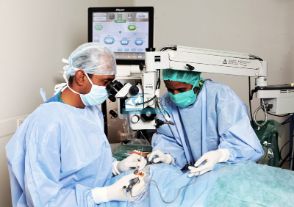Best Cataract Eye Surgeons In Chennai
WHAT IS CATARACT?
A cataract is clouding of the eye's natural lens. it is a natural process of ageing.
Every patient gets it sooner or later. It impairs focusig of light on the retina and hence blurs
vision.

Normal Vision

Blurred images when seen through affected eyes
WHAT ARE THE CAUSES OF CATARACT?
Factors other than ageing may cause cataract as well. Cataract sometimes occurs relatively early in life due to factors such as diabetes, injury, excessive sunlight, toxic chemicals, changes in the body metabolism, drugs or secondary to other eye diseases such as glaucoma and inflammations. They can also be in hereditary predisposition to early occurrence of cataracts
HOW CATARACT AFFECTS YOUR LIFESTYLE?
People with cataract, even when wearing glasses, typically have difficulty in
- Driving at night
- Recognizing colours
- Seeing in distance or reading
- Need frequent changes in their glasses in their glass prescription
TREATMENT OF CATARACT
There are no medications with proven efficacy to prevent or to treat cataract. The only effective treatment or to surgically remove of cataract. Diabetes, hypertension, and other general health problems are not a contraindication for cataract surgery. The cataract need not be mature for its surgical removal. When cataract becomes more mature it naturally becomes hard and thus makes the advanced surgical option difficult, Which means the patient will have no option other than the conventional methods which are uncomfortable in terms of surgical procedure and time consuming in terms of healing and rehabilitation.

Cataract procedure at DRR Hospital
WHEN TO TREAT ?
The decision to treat a cataract is reached by the eye care practitioner and the patient together. This decision is bases on the degree to which cataract is impairing vision and the effect of the impairment on the patient's quality of life.
WHAT IS THE RECOMMENDED TREATMENT FOR CATARACT?
There is no other treatment for cataracts except surgery. Today's cataract surgery is a marvel of medical technology. Often it is performed as an outpatient procedure, under local anesthesia or topical anesthesia.
The decision to treat a cataract is reached by the eye care practitioner and the patient together.
PHACOEMULSIFICATION
Phacoemulsification is the most modern method for cataract removal. In the surgical procedure, the clouded cataractous lens is extracted by fragmenting it into tiny pieces with ultrasound energy and aspirated out with a suction device. Cataract is removed through a small self sealing wound. There are no sutures applied on the eyes
ADVANTAGES OF PHACOEMULSIFICATION
- Stitch less
- Blood less
- Pain less
- Shorter overall duration of surgery
- More controlled surgery
- Early rehabilitation
- Less postoperative discomfort
- Less induced Minimal Astigmatism
- Perfect early restoration of vision
- More satisfied patient
- Minimal or no dependence on glasses
INTRAOCULAR LENSES
An intraocular lens (IOL) is a lens implanted in the eye after cataract removal. 10Ls work by replacing the crystalline lens which has been clouded over by cataracts.
TYPE OF INTRAOCULAR LENSES
There are two main categories of 10Ls. Monofocal and Multifocal lenses. let us have a closer look at this. Different types of Moniocal IOL are :
1. PMMA IOL:
It is made up of inflexible material, hence it is non-foldable and requires a large 6mm incision for the lens to slide inside.
2. HYDROPHILIC FOLDABLE ACRYLIC IOL:
It is commonly implanted into the eye through a small opening of 2.8 mm and it opens up within the eye like a flower. This material has a higher tendency of developing opacification on the natural membrane behind the lens over a period of time.
3. HYDROPHOBIC IOL:
It is considered to be one of the most biocompatible material for IOL. The change of developing opacification on the natural membrane behind the lens is significantly lesser than the earlier mentioned IOLs.
4. ASPHERIC MONOFOCAL IOL:
This IOL gives best quality of sharper vision by significantly lowering the spherical aberration and improve constant sensitivity. This material also has minimal tendency of capsular opacification.
5. ASPHERIC SINGLEPIECE IOL :
This IOL corrects your cataract and at the same time gives the advantage of good quality of vision by mimicking the shape of a natural human lens by eliminating spherical aberration. Subsequent to the implantation of this lens, patient enjoys very good quality of vision. The capsular opacification is practically nil in these lenses .
6. MICRO INCISION (MICS) 1.8/2.2 PHACOEMULSIFICATION
The surgical incision is significantly less in this type of cataract surgery thereby minimising the induced astigmatism which is not less common with a large incision. However, the IOL option here is ASPHERIC SINGLEPIECE IOL.
7. TORIC MONOFOCAL IOL
Toric lenses have more power in one specific region on the lens to correct astigmatism as well as distance vision. The correction of astigmatism with a toric lens requires that the lens be positioned in a very specific configuration. While toric lenses can improve distance vision and astigmatism, the patient still will require corrective lenses for all near tasks, such as reading or writing.
8. MULTIFOCAL IOL
Multifocal intraocular lenses are one of the latest advancement in lens technology. These lenses have a variety of regions with different power that allows some individual to see at various distances, including distance, intermediate, and near. While promising, multifocal lenses are not for everyone. They can cause significantly more glare than monofocal or toric lenses.
REMEMBER
Cataract is the leading cause of decreased vision and blindness in our country.Commoner than the condition are the various misconceptions about cataract and its treatment. This page gives you an overview of the condition and the latest treatment modalities available.



